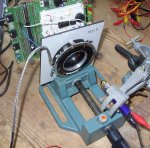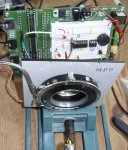I still use film cameras, some of them very old ones, i would like to use the PICAXE to verify the shutter speed. Years ago i made a circuit that measured the shutter speed by using a phototransistor that charged a capacitor and then measured the voltage the capacitor reached, it was done with an op amp and it worked, but i think it would be better done with the picaxe. The way i did it before was by having a flashlight on the lens side and the sensor where film would be.
For the circuit I used a photo transistor with a 100K resistor going to the collector and the emitter grounded. Attached pin 6 of the 20X2 to the junction between collector and 100k resistor. Here is the code I used, I realize 20X2 is overkill but i've been playing with it so i used it,
main:
pulsin c.4,0,W1
if W1<>0 then
sertxd(#W1,13,10)
end if
goto main
I tried it with a Canon AE1P SLR and was getting values that were repeatable so it does seem to work. Example values for 1/60 are:
3938
3812
3852
Any improvement ideas? I also worry that this may not work with cameras that use a leaf shutter.
thanks in advance.
For the circuit I used a photo transistor with a 100K resistor going to the collector and the emitter grounded. Attached pin 6 of the 20X2 to the junction between collector and 100k resistor. Here is the code I used, I realize 20X2 is overkill but i've been playing with it so i used it,
main:
pulsin c.4,0,W1
if W1<>0 then
sertxd(#W1,13,10)
end if
goto main
I tried it with a Canon AE1P SLR and was getting values that were repeatable so it does seem to work. Example values for 1/60 are:
3938
3812
3852
Any improvement ideas? I also worry that this may not work with cameras that use a leaf shutter.
thanks in advance.



